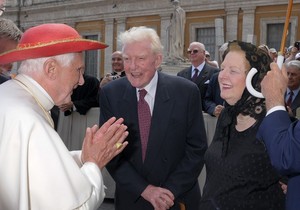Pope Benedict XVI: May 2009 Archives
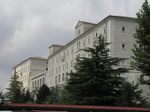
Almost at the end of my visit today, I am particularly pleased to pause in this sacred place, in this abbey, four times destroyed and rebuilt, the last time after the bombings of World War II, 65 years ago. "Succisa virescit" [in defeat we are strengthened; when cut down, this tree grows again]: the words of its new coat of arms represent well its history. Monte Cassino, just as the secular oak tree planted by St. Benedict, was "pruned" by the violence of war, but has risen more vigorous. More than once I also have had the opportunity to enjoy the hospitality of the monks, and in this abbey I spent many unforgettable hours of quiet and prayer. This evening we entered singing "Laudes Regiae" together to celebrate the Vespers of the Solemnity of the Ascension of Jesus. To each of you I express the joy of sharing this moment of prayer, greeting everyone with affection, grateful for the welcome that you have reserved for me and those who accompany me in this apostolic pilgrimage.
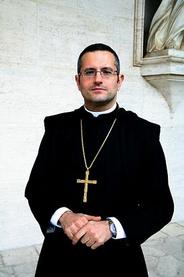
In particular, I greet Abbot Dom Pietro Vittorelli, who has
made himself the spokesman of your common sentiments. I extend my greetings to
the abbots, the abbesses, and to the Benedictine communities present here.
Today the liturgy invites us to contemplate the mystery of the Ascension of the
Lord. In the brief reading taken from the first letter of Peter, we were urged
to fix our gaze on our Redeemer, who died "once and for all for sins"
in order to lead us back to God, at whose right hand he sits "after having
ascended to heaven and having obtained sovereignty over the angels and the
principalities and the powers" (cf. 1 Pt 3, 18.22). "Raised on
high" and made invisible to the eyes of his disciples, Jesus has not
however abandoned them, but was: in fact, "put to death in the body, but
made to live in the spirit" (1 Pt 3:18). He is now present in a new way,
inside the believers, and in him salvation is offered to every human being
without distinction of people, language, or culture. The first letter of Peter
contains specific references to the fundamental Christological events of the
Christian faith. The Apostle's intention is to highlight the universal scope of
salvation in Christ. A similar desire we find in St. Paul, of whom we are
celebrating the two thousandth anniversary of his birth, who to the community
of Corinth, writes: "He (Christ) died for all, so that those who live,
live no longer for themselves but for him, who has died and is risen for
them." (2 Cor 5, 15).
To live no longer for themselves but for Christ: this is
what gives full meaning to the lives of those that let themselves be conquered
by him. The human and spiritual journey of St. Benedict attests to this
clearly, he who, leaving all things behind, dedicated himself to the faithful
following of Jesus. Embodying in his own life the reality of the Gospel, he has
become the founder of a vast movement of spiritual and cultural renaissance in
the West. I would now like to refer to an extraordinary event of his life,
which the biographer St. Gregory the Great relates, and with which you are
certainly well acquainted. One could almost say that the holy patriarch was
"lifted up" in an indescribable mystical experience. On the night of
October 29 of the year 540 -- reads the biography -- and, facing the window,
"with his eyes fixed on the stars he recollected himself in divine
contemplation, the saint felt that his heart was inflamed ... For him, the star
filled firmament was like the embroidered curtain that revealed the Holy of
Holies. At one point, he felt his soul felt itself carried to the other side of
the veil, to contemplate the revealed face of him who dwells in inaccessible
light" (cf. AI Schuster, History of Saint Benedict and his time, Ed Abbey
Viboldone, Milan, 1965, p. 11 et seq.). Of course, similar to what happened to
Paul after his heavenly rapture, St. Benedict, following this extraordinary
spiritual experience, also found it necessary to start a new life. If the
vision was transient, the effects were lasting, his very character -- the
biographers say -- was changed, his appearance always remained calm and his
behavior angelic, and even while he was living on earth, he understood that in
his heart he was already in heaven.
St. Benedict received this gift of God not to satisfy his
intellectual curiosity, but rather because the charism with which God had
endowed him had the ability to reproduce in the monastery the very life of
heaven and reestablish the harmony of creation through contemplation and work.
Rightly, therefore, the Church venerates him as an "eminent teacher of the
monastic life" and "doctor of spiritual wisdom in the love of prayer
and work; shining guide of people in the light of the Gospel" who,
"raised to heaven by a luminous road" teaches people of all ages to
seek God and the eternal riches prepared by him (cf. Preface of the Holy in the
monastery to the MR, 1980, 153).
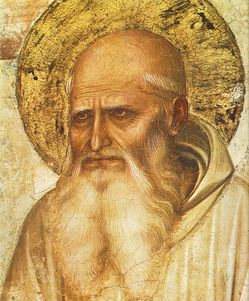
Yes, Benedict was a shining example of holiness and pointed
the monks to Christ as their only great ideal; he was a master of civility, who
proposed a balanced and adequate vision of the demands of God and of the final
ends of man; he also always kept well in mind the needs and the reasons of the
heart, in order to teach and inspire a genuine and constant brotherhood, so
that in the complexity of social relationships the unity of spirit capable of
always building and maintaining peace was never lost sight of. It is not by
chance that the word Pax [peace] is the word that welcomes pilgrims and
visitors at the gates of the abbey, rebuilt after the terrible disaster of the
Second World War, which stands as a silent reminder to reject all forms of
violence in order to build peace: in families, within communities, between
peoples and all of humanity. St. Benedict invites every person that climbs this
mount to seek peace and follow it: "inquire pacem et sequere eam"
[seek peace and follow it.] (Ps. 33,14-15) (Rule, Prologue, 17).
By its example, monasteries have become, over the centuries,
centers of fervent dialogue, encounter and beneficial union of diverse peoples,
unified by the evangelical culture of peace. The monks have known how to teach
by word and example the art of peace, implementing in a concrete way the three
"ties" that Benedict identifies as necessary to maintain the unity of
the Spirit among men: the cross, which is the very law of Christ, the book
which is culture, and the plow, which indicates work, the lordship over matter
and time. Thanks to the activity of the monastery, articulated in the
three-fold daily commitments of prayer, study and work, entire populations of
Europe have experienced a genuine redemption and a beneficial moral, spiritual
and cultural development, learning in the spirit of continuity with the past,
of concrete action for the common good, and of openness to God and the
transcendent aspect of the world. We pray that Europe always exploit this
wealth of principles and Christian ideals, which constitutes an immense
cultural and spiritual wealth.

This is possible but only if the constant teaching of St.
Benedict is embraced, the "quaerere Deum," to seek God, as the
fundamental commitment of man. Human beings cannot achieve full
self-realization or ever be truly happy without God. It is your special
responsibility, dear monks, to be living examples of this interior and profound
relationship with him, implementing without compromise the program that your
founder summarized in the "nihil amori Christi praeponere" [put
nothing before the love of Christ.] (Rule 4.21). In this holiness consists, a
valid proposal for every Christian, more than ever in our time, in which the
need to anchor life and history to solid spiritual principles is felt.
Therefore, dear brothers and sisters, your vocation is as timely as ever, and
your mission as monks is indispensable.
From this place, where his mortal remains rest, the patron
saint of Europe continues to urge everyone to continue his work of
evangelization and human promotion. I encourage you in the first place, dear
brethren, to remain faithful to the spirit of your origins and to be authentic
interpreters of this program of social and spiritual rebirth. The Lord grants
you this gift, through the intercession of your holy founder, of his holy
sister St. Scholastica, and of the saints of your order. And may the heavenly
Mother of the Lord, who today we invoke as "Help of Christians,"
watch over you and protect this abbey and all your monasteries, as well as the
diocesan community that lives around Monte Cassino. Amen!
Pope Benedict XVI, Homily at Vespers II, The Abbey of Monte Cassino, May 24, 2009
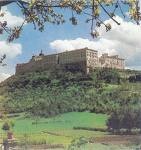
Pope Benedict XVI with great affection for Saint Benedict of Nursia, the Rule of Saint Benedict and Benedictine spirituality made a visit to Monte Cassino, 75 miles southeast of Rome, today. The Abbey of Monte Cassino was founded by Saint Benedict in 529 and it's the sight of great holiness and humanity.
Among the various pastoral engagements the Holy Father had, he celebrated Mass for the diocese in the heart of the city, prayed Vespers with the monks, offered prayers for the dead, and visited the House of Charity. (This house works for peace and the promotion of life.) He also visited the monks of the monastic community there and addressed visiting abbesses and abbots. The Pope was hosted by Abbot-Nullius Pietro Vittorelli, 46.
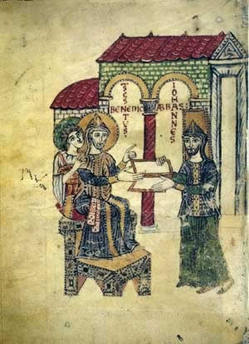
Historically Monte Cassino is a center of art, culture, learning, and faith. The monks at Cassino are quick to recall that the abbey's culture is Neapolitan. Nevertheless, the sole purpose of life in the abbey, indeed in any Benedictine abbey, is the search for God, pressing forward announcing the Paschal Mystery, of which is the incredible fact of Christ's presence known now, that is today. Thus we comprehend the reason for the holy Rule of Benedict: keeping our gaze fixed on Christ.
In Saint Benedict we have a genius who gave cohesion to Europe and the rest of the world through his Rule for monasteries and Lectio Divina. Some will say it is one of the centers of humanity, of Western civilization because the Benedictine life gave voice to the aspirations of men and women. The notable archive at Monte Cassino attests to the search for God and the conscience of the Christian life. A new humanism is underlined by the Rule because it is attentive to one's real humanity seen particularly in the vulnerable of society.
A fascinating heritage of Cassino abbey is the historic presence of the Greek monks who lived there for a few hundred years prior to founding the Abbey of Grottaferrata. Without digressing the Abbey was destroyed four times (in 577, 883, 1349 & 1944) and rebuilt four times. The last time the abbey was destroyed it was bombed by the American military during the Second World War because the Allied armies feared the advance of the enemies. The destruction, however, was carried out under wrong intelligence which the cost the lives of many. However, Succisa virescit! It is the 65th anniversary of the rebuilding of the abbey and city, the icon of beauty, strength and peace all people.
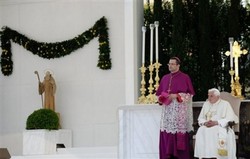
This visit of Pope Benedict is in continuity with the visits of past popes. This is not a first visit of Benedict XVI since he made several visits before as cardinal (but it is the first visit as the first as pope) to Monte Cassino; significantly in 1992 made a few days of retreat with his brother and personal secretary at the abbey and then he worked with Peter Seewald on his book, Salt of the Earth (1997) there. So, as an honor, the Mayor of Cassino announced today that Miranda Square was renamed today to "Pope Benedict XVI Square."
The Pope's homily was incredibly striking and we wait for a proper translation in English.
Blessed is he comes in the Name of the Lord.
The Holy Father gave the following address to the Social Sciences Academy which is led by Mary Ann Glendon. It is a rather important speech with regard to faith and reason and it deserves our serious attention. As supplementary readings you might re-read the Pope's 2008 address to the United Nations and an essay by Tracey Rowland, "Natural Law: From Neo-Thomism to Nuptial Mysticism" in the journal Communio 35 (Fall 2008).
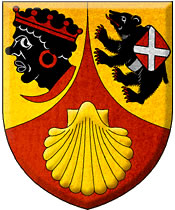
As you gather for the fifteenth Plenary Session of the Pontifical
Academy of Social Sciences, I am pleased to have this occasion to meet with you
and to express my encouragement for your mission of expounding and furthering
the Church's social doctrine in the areas of law, economy, politics and the
various other social sciences. Thanking Professor Mary Ann Glendon for her
cordial words of greeting, I assure you of my prayers that the fruit of your
deliberations will continue to attest to the enduring pertinence of Catholic
social teaching in a rapidly changing world.
After studying work, democracy, globalisation, solidarity
and subsidiarity in relation to the social teaching of the Church, your Academy
has chosen to return to the central question of the dignity of the human person
and human rights, a point of encounter between the doctrine of the Church and
contemporary society.
The world's great religions and philosophies have
illuminated some aspects of these human rights, which are concisely expressed
in "the golden rule" found in the Gospel: "Do to others as you
would have them do to you" (Lk 6:31;
cf. Mt 7:12).
The Church has always affirmed that fundamental rights, above and beyond the
different ways in which they are formulated and the different degrees of
importance they may have in various cultural contexts, are to be upheld and
accorded universal recognition because they are inherent in the very nature of
man, who is created in the image and likeness of God. If all human beings are
created in the image and likeness of God, then they share a common nature that
binds them together and calls for universal respect. The Church, assimilating
the teaching of Christ, considers the person as "the worthiest of
nature" (St. Thomas Aquinas, De potentia, 9, 3) and has taught that the ethical
and political order that governs relationships between persons finds its origin
in the very structure of man's being. The discovery of America and the ensuing
anthropological debate in sixteenth- and seventeenth-century Europe led to a
heightened awareness of human rights as such and of their universality (ius
gentium). The modern
period helped shape the idea that the message of Christ - because it proclaims
that God loves every man and woman and that every human being is called to love
God freely - demonstrates that everyone, independently of his or her social and
cultural condition, by nature deserves freedom. At the same time, we must
always remember that "freedom itself needs to be set free. It is Christ
who sets it free" (Veritatis Splendor, 86).
In the middle of the last century, after the vast suffering
caused by two terrible world wars and the unspeakable crimes perpetrated by
totalitarian ideologies, the international community acquired a new system of
international law based on human rights. In this, it appears to have acted in
conformity with the message that my predecessor Benedict XV proclaimed when he
called on the belligerents of the First World War to "transform the
material force of arms into the moral force of law" ("Note to the
Heads of the Belligerent Peoples", 1 August 1917).
Human rights became the reference point of a shared
universal ethos -
at least at the level of aspiration - for most of humankind. These rights have
been ratified by almost every State in the world. The Second Vatican Council,
in the Declaration Dignitatis Humanae, as well as my predecessors Paul VI and John Paul II,
forcefully referred to the right to life and the right to freedom of conscience
and religion as being at the centre of those rights that spring from human
nature itself.
Strictly speaking, these human rights are not truths of
faith, even though they are discoverable - and indeed come to full light - in
the message of Christ who "reveals man to man himself" (Gaudium et
Spes, 22). They receive
further confirmation from faith. Yet it stands to reason that, living and
acting in the physical world as spiritual beings, men and women ascertain the
pervading presence of a logos which
enables them to
distinguish not only between true and false, but also good and evil, better and
worse, and justice and injustice. This ability to discern - this radical agency - renders every person capable of
grasping the "natural law", which is nothing other than a
participation in the eternal law: "unde...lex naturalis nihil aliud est quam
participatio legis aeternae in rationali creatura" (St. Thomas Aquinas, ST I-II, 91, 2). The natural law is a
universal guide recognizable to everyone, on the basis of which all people can
reciprocally understand and love each other. Human rights, therefore, are ultimately
rooted in a participation of God, who has created each human person with
intelligence and freedom. If this solid ethical and political basis is ignored,
human rights remain fragile since they are deprived of their sound foundation.
The Church's action in promoting human rights is therefore
supported by rational reflection, in such a way that these rights can be
presented to all people of good will, independently of any religious
affiliation they may have. Nevertheless, as I have observed in my Encyclicals,
on the one hand, human reason must undergo constant purification by faith,
insofar as it is always in danger of a certain ethical blindness caused by
disordered passions and sin; and, on the other hand, insofar as human rights
need to be re-appropriated by every generation and by each individual, and
insofar as human freedom - which proceeds by a succession of free choices - is
always fragile, the human person needs the unconditional hope and love that can
only be found in God and that lead to participation in the justice and
generosity of God towards others (cf. Deus Caritas Est, 18, and Spe Salvi, 24).
This perspective draws attention to some of the most
critical social problems of recent decades, such as the growing awareness -
which has in part arisen with globalisation and the present economic crisis -
of a flagrant contrast between the equal attribution of rights and the unequal access to the means of attaining those
rights. For Christians who regularly ask God to "give us this day our
daily bread", it is a shameful tragedy that one-fifth of humanity still
goes hungry. Assuring an adequate food supply, like the protection of vital
resources such as water and energy, requires all international leaders to
collaborate in showing a readiness to work in good faith, respecting the
natural law and promoting solidarity and subsidiarity with the weakest regions
and peoples of the planet as the most effective strategy for eliminating social
inequalities between countries and societies and for increasing global
security.
Dear friends, dear Academicians, in exhorting you in your research and deliberations to be credible and consistent witnesses tot he defence and promotion of these non-negotiable human rights which are founded in divine law, I most willingly impart to you my Apostolic Blessing.
The general intention
That the laity and the Christian communities may be responsible promoters of priestly and religious vocations.
The missionary
intention
That the
recently founded Catholic Churches, grateful to the Lord for the gift of faith,
may be ready to share in the universal mission of the Church, offering their
availability to preach the Gospel throughout the world.
